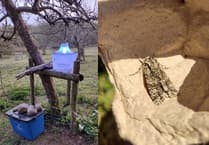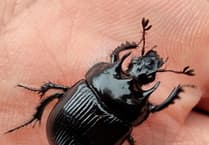A lot is made about the value of tropical rainforests being incredibly important to the health of our planet and as hotspots of biodiversity we really can’t argue against that.
But if it’s just on the oxygen they produce and the carbon they take out of the atmosphere, square metre per square metre on the ground we have something even more important much closer to home – our estuary seagrass meadows, saltmarshes and even their mudflats.
Just as with the rainforest, a lot of it is down to the “plants” … for the purists, yes we are taking a bit of a scientific liberty by grouping the algae, the seaweeds, in with the true plants.
Essentially, the living organisms that use the light energy of the sun to photosynthesise their own food from carbon dioxide in the atmosphere or the water too.
They use this food to build the bodies of their “plants” – the roots, the stems and leaves of true plants, and the holdfast, the stipe and fronds of the seaweeds.
What really marks out our estuarine communities from the rainforests though is that they also trap and build up a huge amount of silt and organic matter that is brought into the estuary.
Either from the rainwater catchment via its streams and rivers (just the streams in the case of the Salcombe-Kingsbridge Estuary) or indeed the sea, brought in by the tides.
This organic matter can be pretty much fragments of anything that has lived and anything from leaves, twigs and bugs on land to plankton and fragments of seaweeds at sea.
Being the remains of living things, this organic matter or detritus, contains a lot of carbon that is held within the building blocks of their cells and structures.
In the relative calm of estuaries, a lot of this detritus effectively “snows” down onto the bed of the estuary, forming the mudflats.
The leaves of seagrass and saltmarsh plants are held up into the water, further calming the water between them and facilitating this snowfall of detritus and building up beneath their plants and meadows.
This sediment and detritus can build up to be many metres deep, containing huge amounts of carbon within them and locked up potentially for thousands of years if left undisturbed.
With our present concerns about carbon emissions and climate change, there is a growing emphasis on conserving and restoring our saltmarshes and seagrass meadows in particular to help accelerate the amount of carbon they take out of the atmosphere ultimately and lock away.
Rainforests do obviously take out great volumes of carbon within their jungles of trees too but such is the rate of recycling of organic matter within them, it doesn’t build up in the same way and typically the soil beneath rainforests is remarkably thin.
There is a growing belief that seaweed gardens and kelp forests in particular, also take up important amounts of carbon but as these seaweeds naturally grow up from shallow rocky seabeds, the organic matter from these does not build directly beneath them but may wash out into the depths of the ocean and snow down onto the colossal beds of deep ooze covering much of the bed of the ocean. Or maybe some too is carried back into our estuaries to be trapped there. Our local champion of carbon trappers are our saltmarshes and in particular those areas of reclaimed land that have been restored to saltmarsh by allowing the saltwater back into them with the tides – a recent example being a project that made the regional news with 55 hectares of historic flood plains being restored to mudflats and saltmarsh within the Otter Estuary in East Devon.
Closer to home is the South Efford Marsh near Aveton Gifford, managed as a nature reserve by the Devon Wildlife Trust.





Comments
This article has no comments yet. Be the first to leave a comment.